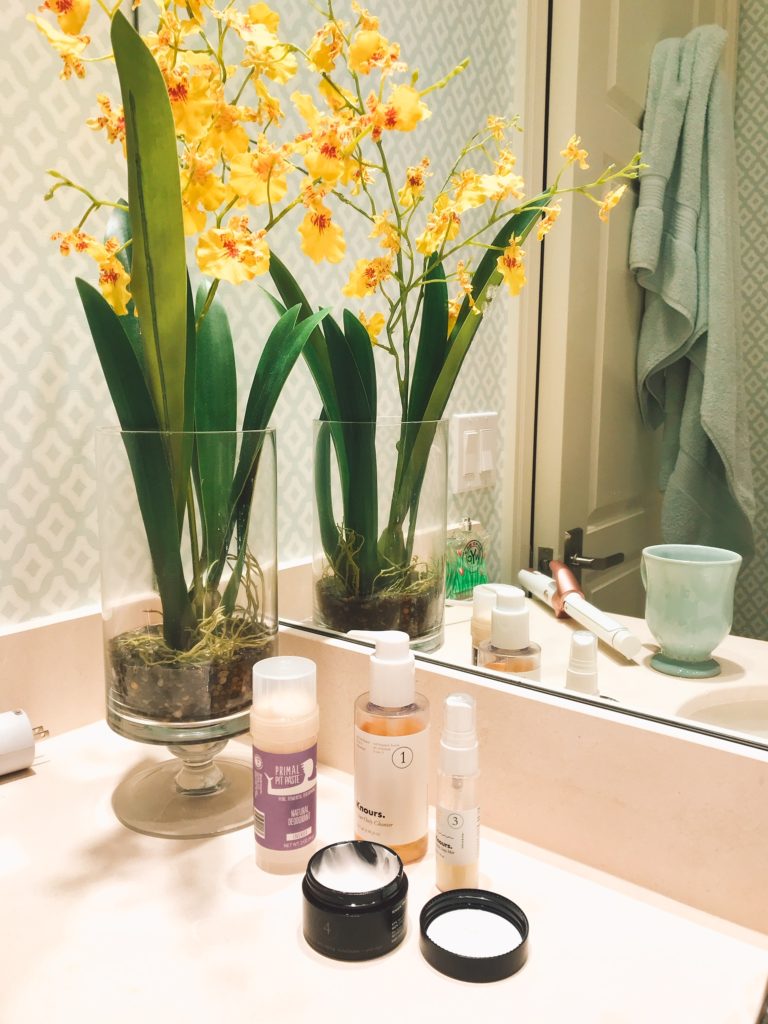
We constantly critique our food, use buzz words like “organic,” “free-range,” “non-gmo….” that all well and good, and it’s superbly important! But, what about the quality of the ingredients we put into the largest organ in our body – THE SKIN? I’ve evolved as an eater in that I typically don’t eat food if I can’t read or don’t understand the ingredients, why would I be okay with putting those on my skin? Trick question, I shouldn’t. In food, I scan the ingredient list for preservatives, anything artificial like MSG, processed, or digestion disrupting items (IE, carrageenan). Actually, it was the Whole 30 that helped me read labels this way when I did it in January ’18, but that is a topic for another time.
Let’s Dig Into Skincare Products
In the same what that it’s important to regulate the food we digest, it’s important to regulate the skincare products our bodies ingest through our pores.
The key here is to really understand what’s inside that pretty (and might I add pricey) bottle. It may seem like a lot of work but i’ve tracked down a great website that you can type either your product name, or if it’s not listed, your list of ingredients into and BAM it rates each one for you, including the level of risk in each ingredient. Find that here. I did this and stopped using my skin care right away. The same applies for your creams, shampoo/conditioner, deodorant (especially!)… anything your body absorbs.
Major & Most Common Offenders?
- Paraben – most common for its mold preventing qualities in many washes, creams, hairsprays, nail polish, and perfumes. These are absorbed into the skin and have been found in breast cancer tumors, directly linking the two. This ingredient has been banned in Europe since 2003.
- Sulfates – the most toxic of them all. When used in combination with other chemicals, they can form nitrosamines, a deadly class of carcinogen. They are used to clean engines, garage floors and at car washes. AND still the most popular ingredients for makeup, shampoo and conditioner and toothpaste. Exposure causes eye damage, depression, diarrhea and many other ailments.
- Phthalates – found in plastics. Phthalates have been found to act as a hormone disruptor linked to reproductive defects, insulin resistance and developmental problems in children.
- DEA/MEA/TEA – These three chemicals are hormone-disrupting chemicals that can form cancer-causing (particularly liver & kidney). The products are commonly found in shampoos, soaps, bubble baths and facial cleansers.
- Benzoyl Peroxide: commonly used for acne treatment, the ingredient has been linked to the production of tumor growth and is noted as toxic to swallow.
- Triclocan: the EPA has classified this as a “pesticide” in food… linked to antibiotic immunity, hormone & thyroid disruptor. Included in most “anti-bacterials”
- Talc: Talc has been linked to ovarian and testicular cancer. It can be found in makeup, baby and adult powders and foundation.
- Artificial Dyes & Synthetic Colors: in almost every item of makeup we wear, these contain heavy metals that our skin actively absorbs.
- “Fragrance”: can represent over 4,000 different ingredients. Most “fragrances” are synthetic and are either cancer-causing or otherwise toxic. Exposure to fragrances has been shown to affect the central nervous system. It is NOT an ingredient..
Impacts of Harmful Ingredients to your Hormonal System
Chemicals that have the ability to mimic the body’s hormones once ingested in the skin are classified as endocrine disruptors. They include the ingredient class parabens (a routinely used preservative; look for words ending in parabenon labels, like butylparaben), and chemical sunscreens (which are often in moisturizers and creams, too, or fall under the guise of fragrance). As the name suggests, endocrine disruptors mess with the endocrine system, which regulates our body’s essential rhythms (like our metabolism, mood, and reproductive processes). The reason that endocrine disruptors are particularly dangerous is counterintuitive at first: They come in very tiny doses. It’s their micro-ness, though, that allows them to impersonate our own hormones (also very tiny), altering the production levels of our hormones and the way they behave. Endocrine disruptors have been linked to severe, long-term health damage, including reproductive issues, birth defects, metabolic problems, and cancer. (Parents take note: Endocrine disruptors are even more of a concern for littles with developing systems.) *cited from goop.com
Recommendations for Beauty Replacements?
Skin Care: goop is fully of swanky, wonderful, and expensive options. I recently discovered Knours where I purchased their full skincare line and just started using it but so far I really like the way it’s made my skin feel. The moisturizer is nice & thick — it feels like it really soaks well into the skin without leaving any residue. Thrive Market is full of great organic, paraben free shower products – I’m using Juice Organics color protecting shampoo and moisturizing conditioner. I found Primal Pit Paste Natural Deodorant Stick, Lavender. Many of these products are available with a link to buy on my products page. That’s a lot to take in! I hope it helped.
xx, jess



